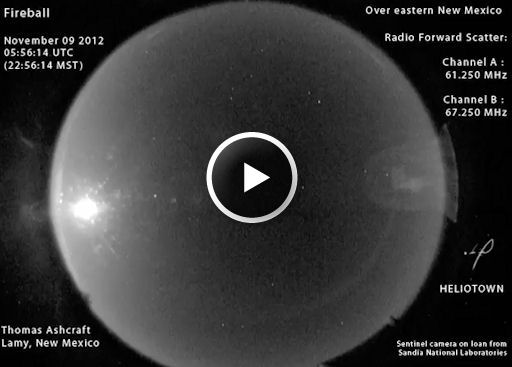Listen to radar echoes from satellites and meteors, live on listener-supported Space Weather Radio. | | |
TOTAL ECLIPSE OF THE SUN: Scientists and sky watchers are converging on the northeast coast of Australia, near the Great Barrier Reef, for a total eclipse of the sun on Nov. 13/14. For researchers, the brief minutes of totality open a window into some of the deepest mysteries of solar physics. [video] [full story]
TAURID METEOR SHOWER: Earth is passing through a stream of gravelly debris from Comet Encke, source of the annual Taurid meteor shower. Because the debris stream is not very congested, Taurid meteor rates are usually low, around 5 per hour. The special thing about Taurids is that they tend to be fireballs. Amateur astronomer Thomas Ashcraft photographed this Taurid exploding over eastern New Mexico on Nov. 9th:

"It was brighter than the full moon and its brightness penetrated the eyelids of sleepers!" says Ashcraft. The disintegrating meteoroid ionized a column of air that acted as a mirror for radio waves. "The soundtrack of the video is the echo of some distant transmitters I recorded at 61.250 MHz and 67.250 MHz," he explains.
Forecasters expect this fireball shower to peak on the nights around Nov. 12th. Monitor the realtime meteor gallery for the latest sightings.
Realtime Meteor Photo Gallery
FARSIDE EXPLOSION: As solar activity picks up on the Earthside of the sun (see "Broken Quiet" below), the farside of the sun is coming alive, too. During the early hours of Nov. 9th, a magnetic filament located behind the sun's southeastern limb erupted, hurling a bright coronal mass ejection (CME) into space:

This explosion was not geoeffective, but future explosions might be. The blast site, still potent, is just days away from rotating onto the Earthside of the sun. You can monitor its progress using NASA's 3D Sun app for smartphones, which makes it easy to view and explore the farside of the sun.
Realtime Space Weather Photo Gallery
BROKEN QUIET: A weeks-long spell of solar quiet was broken on Nov. 8th (02:34 UT), when new sunspot AR1611 unleashed an M1.7-class flare. NASA's Solar Dynamics Observatory captured the extreme UV flash:

Because of the blast site's location on the sun's northeastern limb, Earth was not in the line of fire. It will take about a week for this new active region to turn squarely toward our planet. Stay tuned for updates as the chance of geoeffective flares increases in the days ahead. Solar flare alerts: text, voice.
Realtime Aurora Photo Gallery
Realtime Noctilucent Cloud Photo Gallery
[previous years: 2003, 2004, 2005, 2006, 2007, 2008, 2009, 2011]

